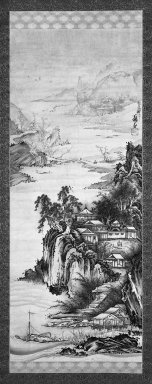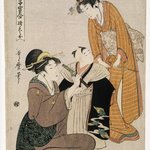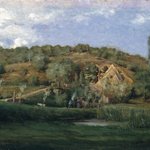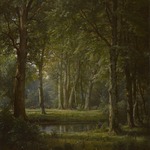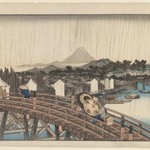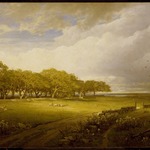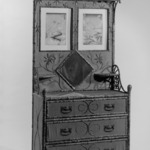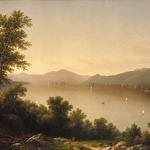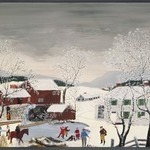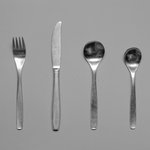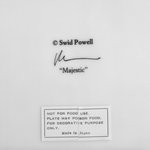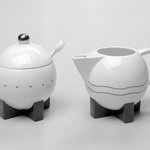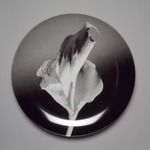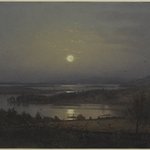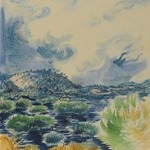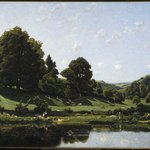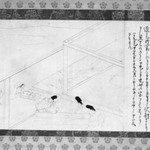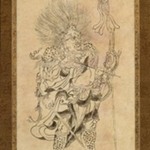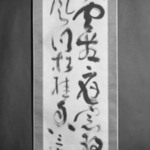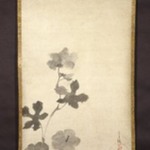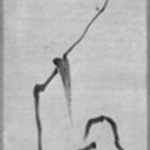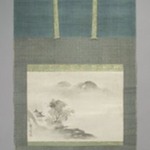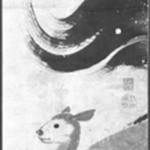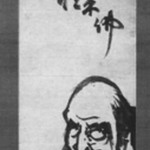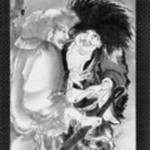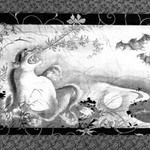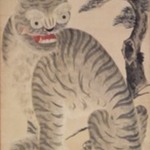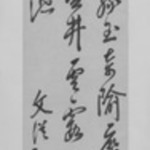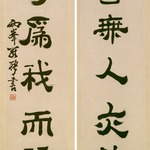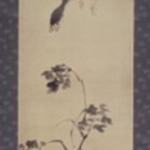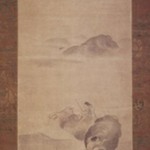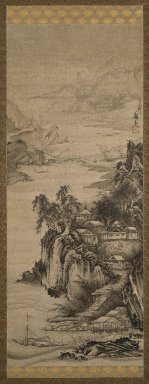
River Landscape
Soga Shohaku
Asian Art
The eighteenth-century painter Soga Shōhaku developed a distinctive style that led to his being labeled an eccentric. Whereas other artists sought to join well-known schools of painting, Shōhaku named as his mentor a monk who was also a painter, Soga Jasoku (a.k.a. Dasoku), who had been dead for three hundred years. Like his distant adopted predecessor, Shōhaku drew on Song-dynasty Chinese landscape painting styles, as seen in this painting with its asymmetrical composition and large areas of empty space. Although this example is relatively conservative in style, some of the artist’s eccentricities can be discerned in his treatment of the rocky overhang at the center and in the strong contrasts of dark and light ink.
MEDIUM
Hanging scroll, Ink on paper
DATES
circa 1760–80
PERIOD
Edo Period
DIMENSIONS
83 5/8 x 26 15/16 in. (212.4 x 68.4 cm)
Image: 54 3/4 x 21 7/8 in. (139.1 x 55.6 cm) (show scale)



MARKINGS
Artist's Seals: three square intaglio seals, red ink
1) ……… (Not yet read)
2) Shohaku
3) Nyoki
SIGNATURE
Signature: Dasokuken Shohaku (black ink, upper right)
COLLECTIONS
Asian Art
ACCESSION NUMBER
1998.39
CREDIT LINE
Gift of the Asian Art Council in memory of Council Member Barbara Young
CATALOGUE DESCRIPTION
River scene with a fishing boat in the foreground and two literati walking up a broad path, with an attendant holding a single scroll, toward a compound of a mountain retreat of a gentleman who stand in an open yard. He is identified by the black cap he wears and his long robes.
He is attended by three men. In the distance there is an idyllic scene of a fisherman and a rider and donkey crossing a bridge spanning the river, and a distant temple on the shoreline of a mountain. In the far distance, there are four sail boats and flocks of geese ascending.
Authenticated by Tsuji Nobuo.
Mount consists of tan and white brocade with repeated gold quatrefoil pattern strips at top and bottom of image with tan and green brocade outer border and thin light blue silk inner border. Ivory scroll ends. Arrived with its own wood box, and old covers with inscriptions: "Meiji 35 (1902): Gift of Baron Kuki Takakazu." "Owned by Tanaka Gentaro."
Condition: Intact. Mount is in very good condition. Image is in good condition. There is extensive painting overall and abrasion and loss throughout especially at top section (3in.). Some wear at the edges of paper.
Label copy: In this painting, we view a distant retreat-possibly a Buddhist temple-in a remote reverie landscape. The scene is common to ink paintings of the Muromachi period (1392-1568) from which the artist Soga Shohaku drew his inspiration. The Composition is characteristic of those older landscapes, combining strong asymmetry, evocative empty spaces, deep recession, and a high vantage point. Yet the painting is very much a product of the eighteenth century with marked ink tones. Shohaku chose the surname soga out of respect for an important monk-painter of Daitokuji, the Zen monastery in Kyoto, Soga Dasoku (died 1483), whose style served as the basis for the informal lineage of ink painters through the sixteenth and seventeenth centuries. Shohaku attempted to affiliate himself with that line, incorporating Dasoku's name in signature and seals, as this landscape painting, where the signature reads Dasokuken Shohaku.
MUSEUM LOCATION
This item is not on view
CAPTION
Soga Shohaku (Japanese, 1730–1781). River Landscape, circa 1760–80. Hanging scroll, Ink on paper, 83 5/8 x 26 15/16 in. (212.4 x 68.4 cm). Brooklyn Museum, Gift of the Asian Art Council in memory of Council Member Barbara Young, 1998.39 (Photo: Brooklyn Museum, 1998.39_IMLS_SL2.jpg)
IMAGE
overall, 1998.39_IMLS_SL2.jpg. Brooklyn Museum photograph
"CUR" at the beginning of an image file name means that the image was created by a curatorial staff member. These study images may be digital point-and-shoot photographs, when we don\'t yet have high-quality studio photography, or they may be scans of older negatives, slides, or photographic prints, providing historical documentation of the object.
RIGHTS STATEMENT
No known copyright restrictions
This work may be in the public domain in the United States. Works created by United States and non-United States nationals published prior to 1923 are in the public domain, subject to the terms of any applicable treaty or agreement.
You may download and use Brooklyn Museum images of this work. Please include caption information from this page and credit the Brooklyn Museum. If you need a high resolution file, please fill out our online application form (charges apply).
The Museum does not warrant that the use of this work will not infringe on the rights of third parties, such as artists or artists' heirs holding the rights to the work. It is your responsibility to determine and satisfy copyright or other use restrictions before copying, transmitting, or making other use of protected items beyond that allowed by "fair use," as such term is understood under the United States Copyright Act.
The Brooklyn Museum makes no representations or warranties with respect to the application or terms of any international agreement governing copyright protection in the United States for works created by foreign nationals.
For further information about copyright, we recommend resources at the United States Library of Congress, Cornell University, Copyright and Cultural Institutions: Guidelines for U.S. Libraries, Archives, and Museums, and Copyright Watch.
For more information about the Museum's rights project, including how rights types are assigned, please see our blog posts on copyright.
If you have any information regarding this work and rights to it, please contact copyright@brooklynmuseum.org.
RECORD COMPLETENESS
Not every record you will find here is complete. More information is available for some works than for others, and some entries have been updated more recently. Records are frequently reviewed and revised, and we welcome any additional information you might have.
